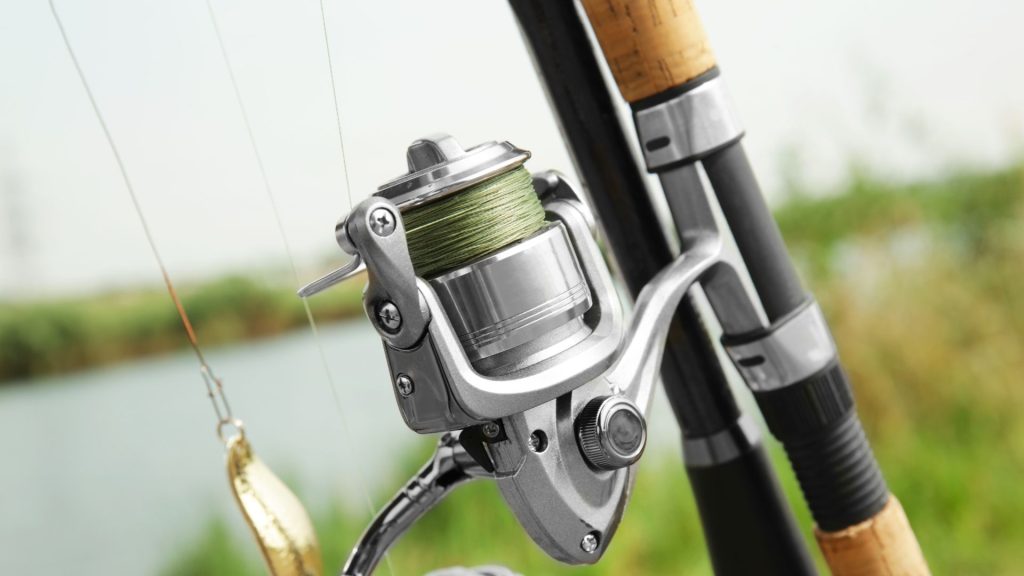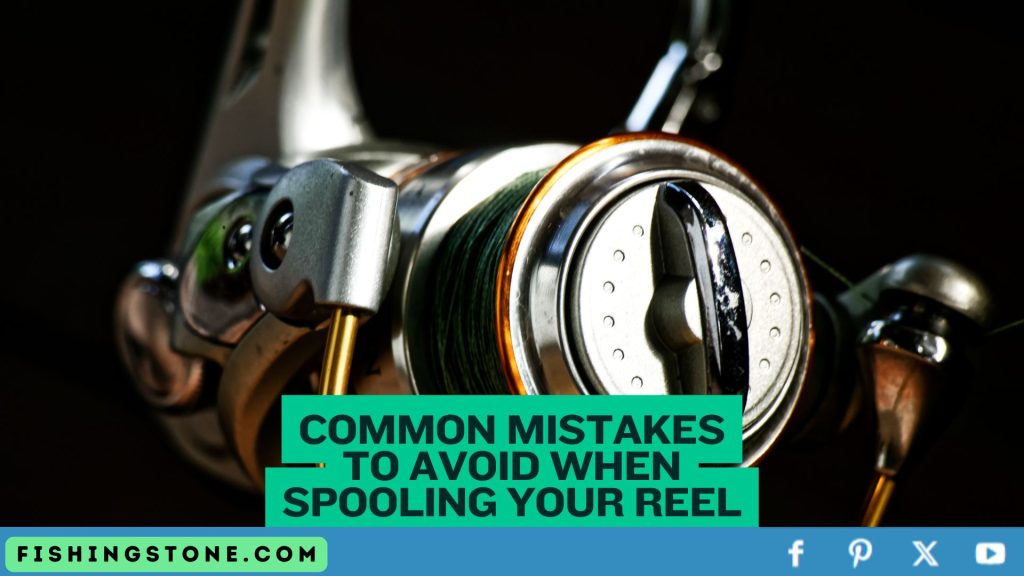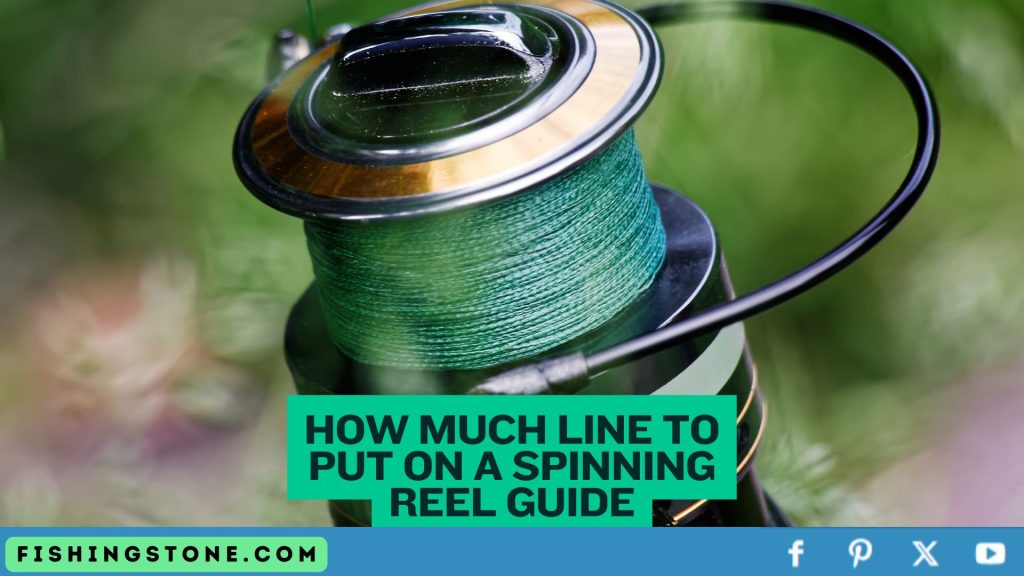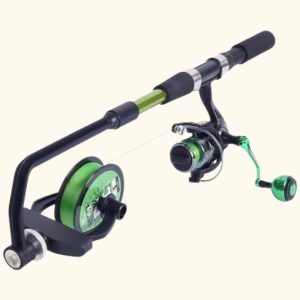How Much Line to Put on a Spinning Reel find out the right line length for your spinning reel. Simple guide helps you to set the right amount.
How Much Line to Put on a Spinning Reel Guide for Accurate Casting and Optimal Performance
Getting your line right on a spinning reel is key to a successful fishing trip. Too little line? You might miss out on casting distance and size. Too much? You risk tangles and poor reel performance.
Whether you’re new to fishing or a seasoned pro, knowing exactly how much line to put on your reel makes a big difference. This guide covers recommended line lengths, what affects capacity, and tips for perfect spooling every time.
DISCLOSURE: Some of the links on this page are affiliate links, meaning, that at no additional cost to you, I may earn a commission if you click through and make a purchase. Affiliate commissions help fund this website, our rare fishing trips and my extreme coffee addiction.
Understanding Your Spinning Reel and Its Line Capacity

Reel Types and Line Compatibility – There are different types of spinning reels suited to various fishing styles. Light reels are best for small fish like trout or panfish, while medium and heavy-duty reels handle bigger species and saltwater. Each reel has a line capacity listed by the manufacturer—often in yards or meters. These specs show the maximum amount of line the spool can hold comfortably. Reel design impacts this as well. A wider spool can hold more line, helping you fish longer without re-spooling mid-trip.
Why Line Capacity Matters – The amount of line on your reel impacts how far and accurately you can cast. If you overfill, the line may spill over, causing tangles or backlash. If you underfill, the reel might not perform well, and you’ll have less line for fighting big fish. Proper capacity also protects your reel’s gears and keeps it running smoothly over time. Think of it like filling a tank—too much or too little affects flow.
Factors Influencing How Much Line to Put on Your Spinning Reel

Fishing Target and Species – Your gear should match what you’re targeting. For small freshwater fish like trout or panfish, lighter lines (4-8 lb test) work best. These need less line and allow for quick, accurate casts. For larger fish such as bass, catfish, or saltwater species, heavier lines (10-20 lb test) are common. Larger fish require more line capacity so you can fight them without breaking off. For example, a saltwater angler fishing for snapper might need a reel loaded with 150-200 yards of 20 lb line.
Type and Weight of the Line – Line comes in different types—monofilament, fluorocarbon, and braided. Braided lines are thinner for the same strength, so they pack more on your reel. Monofilament and fluorocarbon are thicker, so you get less line per yard. Always check the line’s diameter and choose the right type based on your reel’s specs. Thin lines mean more length, but don’t forget to match the line weight to the fish you’re after.
Reel Size and Line Capacity Recommendations – Standard reel sizes often come with suggested line capacities. For example:
- Small reels (like 1000-2500 series): typically hold 120-150 yards of 6-8 lb monofilament.
- Medium reels (3000-4000 series): can fit 150-200 yards of 10-15 lb line.
- Heavy reels (5000+ series): usually hold 200+ yards of heavy line, suited for big game or saltwater fishing.
Using the manufacturer’s line capacity chart helps you choose the right amount of line for your specific reel.
How Much Line to Put on a Spinning Reel: Practical Guidelines
General Guidelines for Common Reel Sizes
- Small reels (1000–2500): about 120-150 yards of 6-8 lb monofilament fishing line or fluorocarbon fishing line, or 150-200 yards of braided fishing line.
- Medium reels (3000–4000): roughly 150-200 yards of 10-15 lb monofilament or fluorocarbon, or 200 yards of braided line.
- Heavy-duty reels (5000 and up): 200+ yards of 20 lb line or stronger for big fish, saltwater, or trolling.
Find in Amazon – Monofilament, fluorocarbon, or braided fishing line.
How much line can a 5000 reel hold? A 5000-yard fishing reel can hold roughly 500 yards of 20-pound test line. If you use lighter line like 10-pound test, you might fit around 1000 yards. Conversely, heavier line, such as 30-pound test, will fill less—about 250 yards. The actual amount depends on the line’s thickness and type. Braided lines are thinner and pack more in, so you can get more on the reel. Monofilament lines are thicker and take up more space. So, whether you get more or less line depends on the line’s diameter. In general, a 5000 reel can hold between 250 to 1000 yards of line, based on line weight and type.
Step-by-Step Spooling Tips for Maximum Performance
- Prepare Your Line: Use a firm surface (like a bucket or rod) to hold the spool steady while filling.
- Maintain Tension: Keep just enough tension on the line as it winds onto the reel to avoid loose loops.
- Even Filling: Fill the spool evenly from side to side to prevent line tangles and uneven casting.
- How Much to Leave Unspooled: Aim to fill the spool up to about 75-80% capacity. That leaves room for line twists and prevents overfilling.
Tip: Use a pencil or similar object pushed through the spool to keep tension steady during spooling.
Buffer Considerations
Leaving a small buffer of unused capacity—around 10-15%—helps prevent overfilling and tangles. This space allows for line adjustments and keeps your reel functioning smoothly.
Common Mistakes to Avoid When Spooling Your Reel

One common mistake is over-tightening the reel when spooling. This can cause the line to crush or weaken. Keeping the tension too loose makes the line curl and tangle easily. Always maintain steady tension that’s firm but not tight. Another error is not using a consistent path when winding.
This leads to uneven layers that can cause snags during use. Always lay the line evenly across the spool. Forgetting to remove twists and knots before winding can cause major problems later. Twisted line can be hard to cast and get tangled. Be sure to straighten out any kinks. Spooling too fast causes uneven distribution.
This can create gaps or bunch up the line. Use a slow, steady pace. Lastly, skipping the step of cleaning the reel before spooling invites dirt and debris. This can damage the line and affect the reel’s performance. Always wipe down your reel to keep it in good shape.
- Overfilling the Spool – Overfilling causes line to spill over the edges or get tangled during casts. It also increases the chance of backlash. Always check the line level and aim for about ¾ full.
- Underfilling the Spool – Underfilling reduces line capacity and can make your reel less effective, especially if fighting large fish. Keep it at least ¾ full, but no more than 90%.
- Using the Wrong Line for Your Reel – Select the line type and weight recommended for your reel. Using thick or incompatible line may cause poor performance and damage.
Expert Tips and Recommendations
- Always review your reel’s instructions before spooling. Each reel has its own capacity limitations.
- Add backing line, like braided, under mono filament to increase capacity without increasing weight.
- Regularly check line for wear and replace it to keep performance high.
- Use tools like a line spooling station or tensioner for better results.
Other Fishing Posts
pros and cons of living on a boat – why fishing is good for you – most valuable antique fishing lures pictures – best places to fish in the United States – Leatherman fishing pliers
Thank you for Reading Our How Much Line to Put on a Spinning Reel Post

Choosing the right amount of line for your spinning reel is crucial for good casting, smooth operation, and longer gear life. Match your line type, length, and reel capacity with your specific fishing needs. Avoid common pitfalls like overfilling or underfilling, and always spool with proper tension. By following these guidelines, you’ll enjoy better fishing experiences and keep your reel in top shape for years to come. Now, head out knowing exactly how much line to put on your reel for your next adventure.
Happy fishing!
We post on several sites on Socia Media. By joining us on your favorite ones you can get updates on our latest Fishing Posts.
Find us on Facebook – Twitter – Pinterest – YouTube
Check out our post on some cool fishing gadgets that any fisherman would enjoy! Do not forget any of these things that could ruin your next fishing trip here.
Hope you have fun Fishing every day. Fish On!
















The amount of line you put on a spinning reel depends on the reel’s size. Check the reel’s capacity written on the spool or in the manual. Usually, it tells you how much line it can hold at specific strengths, like 10 pounds or 15 pounds. A good rule is to fill the spool about 1/8 inch below the edge. This leaves enough room for the line to spin smoothly. Don’t overfill, or the line might bunch up when you cast. If you’re using a heavier line, cut back a little to prevent crowding. If the line is thinner, you can spool more. Always match the line to the reel’s recommended capacity to avoid tangles and ensure good casts. Keep the line tight as you spool it to avoid slack. Use the reel’s label or a simple measuring tape to help. Filling the reel properly helps you cast farther and reduces line twists.
Hey! Figuring out the right amount of line for a spinning reel was a mystery. This article explained it clearly. Thank you for creating it.
With thanks!